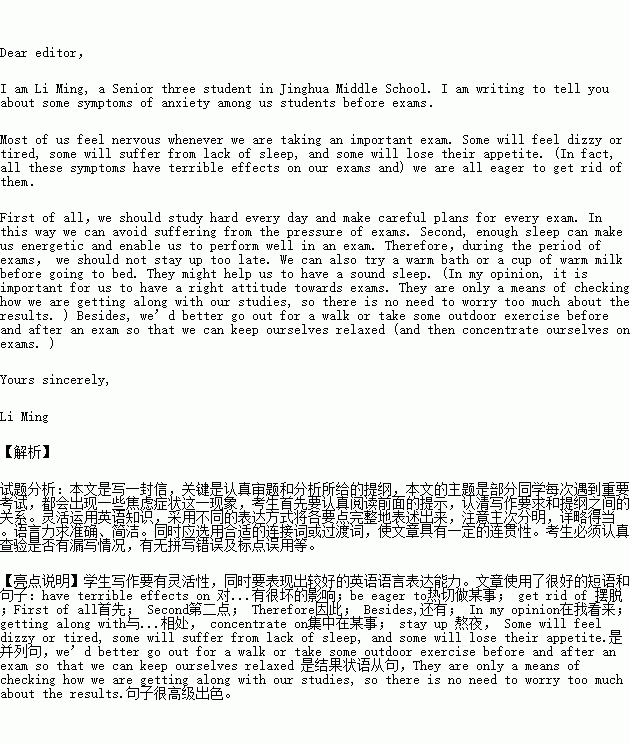��Ŀ����
���������������Ǿ�����ѧһ���߶�ѧ�����㷢�ֲ���ͬѧÿ��������Ҫ���ԣ��������һЩ����֢״��������Ӣ��дһ���ţ���ijѧ��Ӣ�ı��༭��ӳ�����⡣�ŵ�����Ӧ��������Ҫ�㣺
����֢״ | ���� |
ͷ�Ρ�������˯�߲��á�ʳ������� | 1. ��ǰ�ƶ����ʵĸ�ϰ�ƻ��� 2. �����ڼ�������Ϣ�� 3. ˯ǰϴ��ˮ�衢 ����ţ�̵�������˯�ߡ� |
�������飨�����ɿ����Լ��ⶨ�� |
ע�⣺1��������������дһƪ���ģ���Ҫ��䷭�룬���ʵ�����ϸ����ʹ�������ᡣ
2��������100���ҡ���ͷ�Ѹ������������ܴ�����
3���ο��ʻ㣺ͷ��dizzy��
Dear editor��
I am Li Ming��a Senior Three student in Jinghua Middle School��I am writing to tell you
about some symptoms of anxiety among us students before exams��
 ��������ϵ�д�
��������ϵ�д� ����˼ά����ѵ����ʱ��ѧ��ϵ�д�
����˼ά����ѵ����ʱ��ѧ��ϵ�д�Many people in the United States like eggs for breakfast. There are many different ways to cook eggs. One of the most common kinds of eggs for breakfast is scrambled eggs. In addition, this is one of the easiest dishes to cook. Read this recipe(�ط�)for scrambled eggs and you will see how easy it is.
Scrambled Eggs | |
Utensils | Ingredients |
a frying pan a spatula(����) 1 tea spoon a fork or spoon a small bowl | eggs 2 tablespoons of milk or butter salt pepper(����) |
Steps:
1) Melt the butter in a frying pan over medium(���е�)heat.
2) In a small bowl, mix the eggs and the milk. Use the fork (or the spoon) to mix these well.
3) Pour this mixture into the pan.
4) Stir the eggs from time to time with the spatula. Continue until the eggs are no longer liquid.
5) Add salt and pepper. Add a little or a lot, as you like.
1.For this recipe, you do not need __________.
A. a knife B. a spatula C. a bowl D. a fork
2.Which of these steps comes first?
A. Stir the eggs with the spatula.
B. Eat the eggs for breakfast.
C. Add salt and pepper.
D. Mix the eggs and the milk.
3.Which of these words means ��to change from solid to liquid��?
A. pour B. melt C. stir D. scramble

